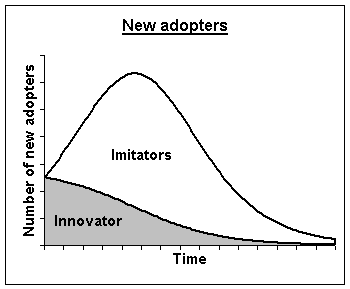FrontPage › DiffusionOfInnovations
Difference between r1.36 and the current
@@ -1,14 +1,73 @@
#title Diffusion Of Innovations [[TableOfContents]]
== Concepts and Ideas ==
* 확산 = diffusion
* 혁신 = innovation (or ideas, technologies, news, etc.)
* 2 step flow theory vs. bullet theory ([[wiki:ResearchMethodsLectureNote#s-2.2.1 Note 2.2.1]] and [[wiki:ResearchMethodsLectureNote#s-2.2.2 Note 2.2.2]] 참조). AKA 피하주사 모델 (hyperdermic needle model)
* Ohio Eerie County 연구: 대톨령 선거에서의 매스미디어의 역할 (정치적 결정의 변화)
* Mass media X :: Interpersoanl O
* Importance of Communication channel (communication network)
* 개혁 ::
* Knowledge ---> Mass media
* Persuasion ---> Interpersonal
* Decision
* Implementation
* Confirmation
* 의견지도자 (...력) = opinion leaders (or opinion leadership)
----
* 소시오그램 (sociogram)
* 커뮤니케이션 네트워크 (Communication network)
* 동질성 과 이질성 (homophily and heterophily)
* 동질성 :: 커뮤니케이션 효과(effects of communication)
* 확산의 걸림돌
* [wiki:DiffusionOfInnovations#s-2.8.1 확산 일반화]
* 이질성 :: 확산의 잠재력
* the Strength of Weak Ties . . . by Mark Granovetter (1973)
* 확산 그래프 (diffusion graph)
* 팩스의 확산 예, pp. 90-91
* 인터넷의 확산 (1969 - - - - - - - - - - 1995 - - - - - - ) See [wiki:InternetHistory Internet History]
* 사회학습이론 (Social Learning Theory)
* Observational (or social) modeling --- of (others' behavior)
* 언어, 비언어, 관찰, 습득, 미디어 콘텐츠, 학습 . . . .
* 결정적 다수 (critical mass)
* Olson --> [wiki:CollectiveActionTheory Collective Action Theory (집단행동이론)]
* Network externalities (네트워크 외부성) or compatibilities (호환성)
* the Internet vs. mobile phone
* SONOS . . . [http://sonos.com Sonos] or [http://www.amazon.com/gp/product/B003CP0FUU/ref=s9_al_bw_g23_i1 Sonos at Amazon]
* VCR의 보급 -- Beta vs. VHS
* 개인적 임계점 혹은 분계점
* pluralistic ignorance
* 전략 (to reach to the Critical Mass)
* Idea/Policy/Technology 와 관련한 사회적 영향력이 많은 집단을 표적(target)으로
* Pluralistic Ignorance . . . 강조
* 집단을 분리하여 소수집단(개혁성이 높은 집단 등)에서의 성공예를 만드는 노력 (이메일 -- sales dept. vs. R&D dept.)
* How to IDENTIFY the OLs? (table 8.1)
* 사획관계측정
* 정보제공자의 평가
* 자기추천방식
* 관찰
* e.g., 미디어학과에서 (캐리어와 학업의) 진로결정에 있어서 영향력을 미치는 자는 누구인가?
== Book: Diffusion of Innovations ==
역자 서문 v저자 서문 viii
== 01 확산의 요소 ==
=== 01 확산의 요소 ===
어느 페루 촌락의 물 끓여 마시기 캠페인: 실패한 확산 1확산이란 무엇인가? 5
영국 해군의 괴혈병 통제 7
드보랙 키보드의 비확산 8
* https://www.addedbytes.com/content/dvorak-vs-qwerty/qwerty.gif
* https://www.addedbytes.com/content/dvorak-vs-qwerty/dvorak.gif
* Dvorak: minimal finger and wrist movement; less movements for weak fingers; etc. --> scientific
* QWERTY: invented for traditional typewriter mechanisms.
1. 개혁 11
2. 커뮤니케이션 채널 18
@@ -22,7 +81,7 @@
3. 시간 394. 사회체계 40
== 02 확산 연구의 역사 ==
=== 02 확산 연구의 역사 ===
유럽에서의 확산 연구의 시작 44
가브리엘 따르드와 모방 44
@@ -54,7 +113,7 @@
확산 연구의 유형학 99요약 105
== 03 확산 연구의 기여와 비판 ==
=== 03 확산 연구의 기여와 비판 ===
오늘날의 확산 연구의 위치 107
확산 연구에 대한 비판 110
@@ -66,7 +125,7 @@
개혁 확산에서의 평등성 문제 136요약 141
== 04 개혁의 발생 ==
=== 04 개혁의 발생 ===
개혁개발 과정 144
1. 문제 및 필요에 대한 인식 144
@@ -91,7 +150,7 @@
농업 협력 모델 173요약 174
== 05 개혁결정 과정 ==
=== 05 개혁결정 과정 ===
개혁결정 과정 모델 177
K-P-D-I-C
@@ -144,7 +203,7 @@
인터넷이 어떻게 개혁 결정 과정을 변화시키고 있는가 227요약 228
== 06 개혁의 특성과 채택률 ==
=== 06 개혁의 특성과 채택률 ===
백인 미국사회의 흑인 음악: 랩 232
@@ -185,7 +244,7 @@
휴대전화와 라이프스타일 혁명 276요약 281
== 07 개혁성과 채택자 범주 ==
=== 07 개혁성과 채택자 범주 ===
'''안데스 콜롬비아 마을의 농업 개혁의 확산 285''''''개혁성에 기초한 채택자 범주 분류 288'''
@@ -216,6 +275,7 @@
'''사회경제적 특성 306''''''개성 변인 307'''
'''커뮤니케이션 행위 309'''
[[Attachment(2013-04-01_101311.png,width=400,selflink,caption="A Summary of the Research Evidence Supporting and Not Supporting Generalizations about the Characteristics of Adopter Categories.")]]
'''수용자 세분화와 채택자 범주 311''''''홍콩에서의 휴대전화 비개혁자 313'''
'''개혁성-필요 패러독스와 최소 저항의 전략 314'''
@@ -223,46 +283,50 @@
'''네트워크의 개혁성에 미치는 영향 316''''''요약 317'''
1. Generalization 7-1 states that: Adopter distributions follow a bellshaped curve over time and approach normality.
1. Generalization 7-1: Adopter distributions follow a bellshaped curve over time and approach normality.
1. Generalization 7-2: Earlier adopters are not different from later adopters in age. There is inconsistent evidence about the relationship of age and innovativeness; about half of the 228 studies on this subject show no relationship, 19 percent show that earlier adopters are younger, and 33 percent indicate they are older. 1. Generalization 7-3: Earlier adopters have more years of education than later adopters have.
1. Generalization 7-4: Earlier adopters are more likely to be literate than are later adopters.
1. Generalization 7-5: Earlier adopters have higher social status than later adopters.
1. Generalization 7-6: Earlier adopters have a greater degree of upward social mobility than later adopters.
1. Generalization 7-3: Earlier adopters have more years of '''education''' than later adopters have.
1. Generalization 7-4: Earlier adopters are more likely to be '''literate''' than are later adopters.
1. Generalization 7-5: Earlier adopters have higher '''social status''' than later adopters.
1. Generalization 7-6: Earlier adopters have a greater degree of upward '''social mobility''' than later adopters.
1. Generalization 7-7: Earlier adopters have larger-sized units (farms, companies, and so on) than later adopters (Figure 7-3). 1. Generalization 7-8: Earlier adopters are more likely to have a commercial (rather than a subsistence) economic orientation than are later adopters. A subsistence orientation is typified by a village farmer who produces only for his own consumption and not for sale Innovativeness is higher with the advent of a commercial orientation in which farm products are raised for market.
1. Generalization 7-9: Earlier adopters have a more favorable attitude toward credit (borrowing money) than later adopters.
1. Generalization 7-10: Earlier adopters have more specialized operations than later adopters.
1. Generalization 7-11: Earlier adopters have greater empathy than later adopters.
1. Generalization 7-12: Earlier adopters may be less dogmatic than later adopters.
1. Generalization 7-13: Earlier adopters have a greater ability to deal with abstractions than later adopters.
1. Generalization 7-14: Earlier adopters have greater rationality than later adopters.
1. Generalization 7-15: Earlier adopters have greater intelligence than later adopters.
1. Generalization 7-16: Earlier adopters have a more favorable attitude toward change than later adopters.
1. Generalization 7-17: Earlier adopters are more able to cope with uncertainty and risk than later adopters.
1. Generalization 7-18: Earlier adopters have a more favorable attitude toward education than later adopters.
1. Generalization 7-19: Earlier adopters have a more favorable attitude toward science than later adopters. Because most innovations are the products of scientific research, it is logical that innovators should be more favorably inclined toward science.
1. Generalization 7-20: Earlier adopters are less fatalistic than later adopters. Fatalism is the degree to which an individual perceives a lack of ability to control his or her future. An individual is more likely to adopt an innovation if he or she believes that he or she is in control, rather than thinking that the future is determined by fate.
1. Generalization 7-21: Earlier adopters have higher levels of achievement motivation than later adopters. Achievement motivation is a social value that emphasizes a desire for excellence in order for an individual to attain a sense of personal accomplishment.
1. Generalization 7-22: Earlier adopters have higher aspirations (for education, occupations, and so on) than later adopters.
1. Generalization 7-23: Earlier adopters have more social participation than later adopters.
1. Generalization 7-24: Earlier adopters are more highly interconnected in the social system than later adopters.
1. Generalization 7-25: Earlier adopters are more cosmopolite than later adopters.
1. Generalization 7-26: Earlier adopters have more change agent contact than later adopters (Figure 7-3).
1. Generalization 7-27: Earlier adopters have greater exposure to mass media communication channels than later adopters.
1. Generalization 7-28: Earlier adopters have greater exposure to interpersonal communication channels than later adopters.
1. Generalization 7-29: Earlier adopters seek information about innovations more actively than later adopters.
1. Generalization 7-30: Earlier adopters have greater knowledge of innovations than later adopters.
1. Generalization 7-31: Earlier adopters have a higher degree of opinion leadership than later adopters.
1. Generalization 7-32: Earlier adopters are more likely to belong to highly interconnected systems than are later adopters.
== 08 확산 네트워크 ==
1. Generalization 7-8: Earlier adopters are more likely to have a commercial (rather than a subsistence) '''economic orientation''' than are later adopters. A subsistence orientation is typified by a village farmer who produces only for his own consumption and not for sale Innovativeness is higher with the advent of a commercial orientation in which farm products are raised for market.
1. Generalization 7-9: Earlier adopters have a more favorable attitude toward '''credit (borrowing money)''' than later adopters.
1. Generalization 7-10: Earlier adopters have more '''specialized operations''' than later adopters.
1. Generalization 7-11: Earlier adopters have greater '''empathy''' than later adopters.
1. Generalization 7-12: Earlier adopters may be less '''dogmatic''' than later adopters.
1. Generalization 7-13: Earlier adopters have a greater '''ability to deal with abstractions''' than later adopters.
1. Generalization 7-14: Earlier adopters have greater '''rationality''' than later adopters.
1. Generalization 7-15: Earlier adopters have greater '''intelligence''' than later adopters.
1. Generalization 7-16: Earlier adopters have a more favorable '''attitude toward change''' than later adopters.
1. Generalization 7-17: Earlier adopters are more '''able to cope with uncertainty and risk''' than later adopters.
1. Generalization 7-18: Earlier adopters have a more favorable '''attitude toward education''' than later adopters.
1. Generalization 7-19: Earlier adopters have a more favorable '''attitude toward science''' than later adopters. Because most innovations are the products of scientific research, it is logical that innovators should be more favorably inclined toward science.
1. Generalization 7-20: Earlier adopters are less '''fatalistic''' than later adopters. Fatalism is the degree to which an individual perceives a lack of ability to control his or her future. An individual is more likely to adopt an innovation if he or she believes that he or she is in control, rather than thinking that the future is determined by fate.
1. Generalization 7-21: Earlier adopters have higher levels of '''achievement motivation''' than later adopters. Achievement motivation is a social value that emphasizes a desire for excellence in order for an individual to attain a sense of '''personal accomplishment'''.
1. Generalization 7-22: Earlier adopters have higher '''aspirations''' (for education, occupations, and so on) than later adopters.
1. Generalization 7-23: Earlier adopters have more '''social participation''' than later adopters.
1. Generalization 7-24: Earlier adopters are more highly '''interconnected''' in the social system than later adopters.
1. Generalization 7-25: Earlier adopters are more '''cosmopolite''' than later adopters.
1. Generalization 7-26: Earlier adopters have more '''change agent contact''' than later adopters (Figure 7-3).
1. Generalization 7-27: Earlier adopters have greater '''exposure to mass media communication channels''' than later adopters.
1. Generalization 7-28: Earlier adopters have greater '''exposure to interpersonal communication channels''' than later adopters.
1. Generalization 7-29: Earlier adopters seek '''information about innovations''' more actively than later adopters.
1. Generalization 7-30: Earlier adopters have greater '''knowledge of innovations''' than later adopters.
1. Generalization 7-31: Earlier adopters have a higher '''degree of opinion leadership''' than later adopters.
1. Generalization 7-32: Earlier adopters are more likely to '''belong to highly interconnected systems''' than are later adopters.
=== 08 확산 네트워크 ===
근대 수학의 확산에 있어서 의견지도력 320
커뮤니케이션 흐름에 대한 모델들 322
피하주사 모델 322
* Bullet theory | Hyper-needle Model (of Communication)
2단계 흐름 모델 323 * Two step flow
* weakness of mass communication
* finding of opinion leader
* the importance of interpersonal communication
커뮤니케이션 네트워크에서의 동질성과 이질성 325동질성과 이질성 325
확산의 걸림돌로서의 동질성 326
@@ -304,7 +368,25 @@
결정적 다수에 이르기 위한 전략 384요약 386
== 09 개혁주도자 ==
==== 일반화 ====
1. Generalization 8-1: Interpersonal diffusion networks are mostly homophilous.
1. Generalization 8-2: When interpersonal diffusion networks are heterophilous, followers seek opinion leaders of higher socioeconomic status.
1. Generalization 8-3: When interpersonal diffusion networks are heterophilous, followers seek opinion leaders with more education.
1. Generalization 8-4: When interpersonal diffusion networks are heterophilous, followers seek opinion leaders with greater mass media exposure.
1. Generalization 8-5: When interpersonal diffusion networks are heterophilous, followers seek opinion leaders who are more cosmopolite.
1. Generalization 8-6: When interpersonal diffusion networks are heterophilous, followers seek opinion leaders with greater change agent contact.
1. Generalization 8-7: When interpersonal diffusion networks are heterophilous, followers seek opinion leaders who are more innovative.
1. Generalization 8-8: Opinion leaders have greater exposure to mass media than their followers.
1. Generalization 8-9: Opinion leaders are more cosmopolite than their followers.
1. Generalization 8-10: Opinion leaders have greater change agent contact than their followers (Figure 8-2).
1. Generalization 8-11: Opinion leaders have greater social participation than their followers.
1. Generalization 8-12: Opinion leaders have higher socioeconomic status than their followers.
1. Generalization 8-13: Opinion leaders are more innovative than their followers (Figure 8-2).
1. Generalization 8-14: When a social system's norms favor change, opinion leaders are more innovative, but when the norms do not favor change, opinion leaders are not especially innovative.
1. Generalization 8-15 states that: The interconnectedness of an individual in a social system is positively related to the individual's innovativeness.
1. Generalization 8-16: The information-exchange potential of communication network links is negatively related to their degree of(1) communication proximity and (2) homophily. *
1. Generalization 8-17 states: Individuals tend to be linked to others who are close to them in physical distance and who are relatively homophilous in social characteristics. *
=== 09 개혁주도자 ===
표적화 390
@@ -339,7 +421,7 @@
탈중심적 확산의 장단점 424요약 426
== 10 조직에서의 개혁 ==
=== 10 조직에서의 개혁 ===
개혁 결정의 유형 430
@@ -365,7 +447,7 @@
조직의 새로운 커뮤니케이션 기술 461요약 461
== 11 개혁의 결과 ==
=== 11 개혁의 결과 ===
북극구(atctic)의 설상차 혁명 465개혁 결과에 관한 연구 467
@@ -392,6 +474,6 @@
디지털 격차 499요약 500
== ... ==
=== ... ===
관련 문헌 목록 503찾아보기 574
1. Concepts and Ideas ¶
- 확산 = diffusion
- 혁신 = innovation (or ideas, technologies, news, etc.)
- 2 step flow theory vs. bullet theory (Note 2.2.1 and Note 2.2.2 참조). AKA 피하주사 모델 (hyperdermic needle model)
- Ohio Eerie County 연구: 대톨령 선거에서의 매스미디어의 역할 (정치적 결정의 변화)
- Mass media X :: Interpersoanl O
- Importance of Communication channel (communication network)
- 개혁 ::
- Knowledge ---> Mass media
- Persuasion ---> Interpersonal
- Decision
- Implementation
- Confirmation
- Knowledge ---> Mass media
- Ohio Eerie County 연구: 대톨령 선거에서의 매스미디어의 역할 (정치적 결정의 변화)
- 의견지도자 (...력) = opinion leaders (or opinion leadership)
- 소시오그램 (sociogram)
- 커뮤니케이션 네트워크 (Communication network)
- 동질성 과 이질성 (homophily and heterophily)
- 동질성 :: 커뮤니케이션 효과(effects of communication)
- 확산의 걸림돌
- 확산 일반화
- 확산의 걸림돌
- 이질성 :: 확산의 잠재력
- the Strength of Weak Ties . . . by Mark Granovetter (1973)
- the Strength of Weak Ties . . . by Mark Granovetter (1973)
- 동질성 과 이질성 (homophily and heterophily)
- 확산 그래프 (diffusion graph)
- 팩스의 확산 예, pp. 90-91
- 인터넷의 확산 (1969 - - - - - - - - - - 1995 - - - - - - ) See Internet History
- 팩스의 확산 예, pp. 90-91
- 사회학습이론 (Social Learning Theory)
- Observational (or social) modeling --- of (others' behavior)
- 언어, 비언어, 관찰, 습득, 미디어 콘텐츠, 학습 . . . .
- Observational (or social) modeling --- of (others' behavior)
- 결정적 다수 (critical mass)
- Olson --> Collective Action Theory (집단행동이론)
- Network externalities (네트워크 외부성) or compatibilities (호환성)
- the Internet vs. mobile phone
- SONOS . . .
![[http]](/imgs/http.png) Sonos or
Sonos or ![[http]](/imgs/http.png) Sonos at Amazon
Sonos at Amazon
- VCR의 보급 -- Beta vs. VHS
- the Internet vs. mobile phone
- 개인적 임계점 혹은 분계점
- pluralistic ignorance
- pluralistic ignorance
- 전략 (to reach to the Critical Mass)
- Idea/Policy/Technology 와 관련한 사회적 영향력이 많은 집단을 표적(target)으로
- Pluralistic Ignorance . . . 강조
- 집단을 분리하여 소수집단(개혁성이 높은 집단 등)에서의 성공예를 만드는 노력 (이메일 -- sales dept. vs. R&D dept.)
- Idea/Policy/Technology 와 관련한 사회적 영향력이 많은 집단을 표적(target)으로
- Olson --> Collective Action Theory (집단행동이론)
- How to IDENTIFY the OLs? (table 8.1)
- 사획관계측정
- 정보제공자의 평가
- 자기추천방식
- 관찰
- e.g., 미디어학과에서 (캐리어와 학업의) 진로결정에 있어서 영향력을 미치는 자는 누구인가?
- 사획관계측정
2.1. 01 확산의 요소 ¶
어느 페루 촌락의 물 끓여 마시기 캠페인: 실패한 확산 1
확산이란 무엇인가? 5
영국 해군의 괴혈병 통제 7
드보랙 키보드의 비확산 8
영국 해군의 괴혈병 통제 7
드보랙 키보드의 비확산 8
- Dvorak: minimal finger and wrist movement; less movements for weak fingers; etc. --> scientific
- QWERTY: invented for traditional typewriter mechanisms.
1. 개혁 11
2. 커뮤니케이션 채널 18
3. 시간 21
4. 사회체계 25
아이오와의 잡종 옥수수 확산 34
요약 38
1. 개혁 38
2. 커뮤니케이션 채널 39
3. 시간 39
4. 사회체계 40
1. 개혁 38
2. 커뮤니케이션 채널 39
3. 시간 39
4. 사회체계 40
2.2. 02 확산 연구의 역사 ¶
유럽에서의 확산 연구의 시작 44
가브리엘 따르드와 모방 44
게오르그 짐멜의 이방인 45
영국과 독일-오스트리아의 확산론자들 46
가브리엘 따르드와 모방 44
게오르그 짐멜의 이방인 45
영국과 독일-오스트리아의 확산론자들 46
확산 연구전통의 등장 47
패러다임과 비공식 연구집단 49
인류학 연구전통 51
발리에서 기적의 쌀: “여신과 컴퓨터” 53
초기 사회학 55
농촌 사회학 57
교육학 65
피츠버그에서의 근대 수학의 확산 67
유치원의 세계적인 확산 67
공중보건 및 의료사회학 68
콜롬비아대학교의 의약 확산 연구 69
타이충 현장 실험 74
샌프란시스코의 STOP AIDS 프로그램 76
커뮤니케이션학 77
9·11 테러리스트 공격에 관련된 뉴스의 확산 84
마케팅 87
전기 자동차 확산에서의 의견지도자들과 메이번 93
지리학 95
일반 사회학 96
프리덤 섬머 참가 모집에 있어서의 네트워크 97
패러다임과 비공식 연구집단 49
인류학 연구전통 51
발리에서 기적의 쌀: “여신과 컴퓨터” 53
초기 사회학 55
농촌 사회학 57
교육학 65
피츠버그에서의 근대 수학의 확산 67
유치원의 세계적인 확산 67
공중보건 및 의료사회학 68
콜롬비아대학교의 의약 확산 연구 69
타이충 현장 실험 74
샌프란시스코의 STOP AIDS 프로그램 76
커뮤니케이션학 77
9·11 테러리스트 공격에 관련된 뉴스의 확산 84
마케팅 87
전기 자동차 확산에서의 의견지도자들과 메이번 93
지리학 95
일반 사회학 96
프리덤 섬머 참가 모집에 있어서의 네트워크 97
확산 연구전통의 경향 99
확산 연구의 유형학 99
요약 105
확산 연구의 유형학 99
요약 105
2.3. 03 확산 연구의 기여와 비판 ¶
오늘날의 확산 연구의 위치 107
확산 연구에 대한 비판 110
학산 연구의 친개혁적 편향 111
이집트 마을의 깨끗한 식수 112
인도와 중국의 아들 선호 121
확산 연구의 개인 책임 편향 122
확산 연구에 있어서의 회상의 문제 132
개혁 확산에서의 평등성 문제 136
요약 141
확산 연구에 대한 비판 110
학산 연구의 친개혁적 편향 111
이집트 마을의 깨끗한 식수 112
인도와 중국의 아들 선호 121
확산 연구의 개인 책임 편향 122
확산 연구에 있어서의 회상의 문제 132
개혁 확산에서의 평등성 문제 136
요약 141
2.4. 04 개혁의 발생 ¶
개혁개발 과정 144
1. 문제 및 필요에 대한 인식 144
2. 기초 연구와 응용 연구 146
도시바에서의 노트북 컴퓨터의 탄생 151
3. 개발 153
냉장고는 왜 소음을 내는가? 154
새 상품인 세그웨이를 분류하는 방식 155
4. 상업화 160
제록스 PARC의 어설픈 미래 예측 161
5. 확산의 채택 163
6. 개혁의 결과 165
우연히 발견한 워퍼린 165
1. 문제 및 필요에 대한 인식 144
2. 기초 연구와 응용 연구 146
도시바에서의 노트북 컴퓨터의 탄생 151
3. 개발 153
냉장고는 왜 소음을 내는가? 154
새 상품인 세그웨이를 분류하는 방식 155
4. 상업화 160
제록스 PARC의 어설픈 미래 예측 161
5. 확산의 채택 163
6. 개혁의 결과 165
우연히 발견한 워퍼린 165
사회경제적 지위, 평등 그리고 개혁개발 166
캘리포니아의 단단한 토마토 167
캘리포니아의 단단한 토마토 167
개혁개발 과정 추적 169
추적 연구의 단점 171
개혁개발 과정에 대한 향후 연구 과제 172
추적 연구의 단점 171
개혁개발 과정에 대한 향후 연구 과제 172
농업 협력 모델 173
요약 174
요약 174
2.5. 05 개혁결정 과정 ¶
개혁결정 과정 모델 177
K-P-D-I-C
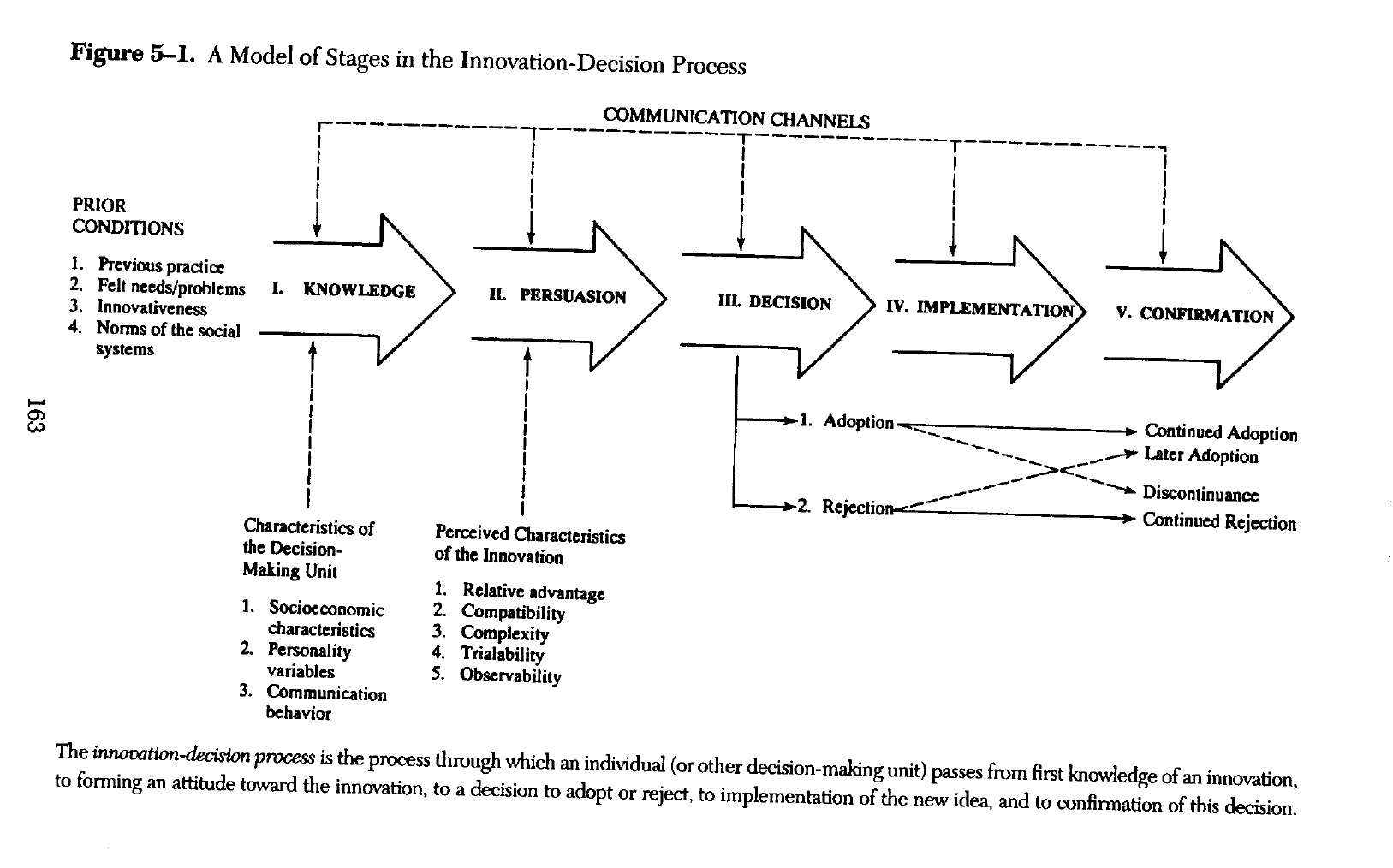
K-P-D-I-C

Innovation Process [JPG image (278.54 KB)]
지식 단계 178
개혁에 대한 필요 혹은 인지 중 어느 것이 먼저 나타나는가? 178
개혁에 관한 지식의 세 가지 유형 180
개혁을 일찍 알게 된 사람 대 늦게 알게 된 사람 182
개혁에 대한 필요 혹은 인지 중 어느 것이 먼저 나타나는가? 178
개혁에 관한 지식의 세 가지 유형 180
개혁을 일찍 알게 된 사람 대 늦게 알게 된 사람 182
설득 단계 183
결정 단계 186
실행 단계 188
과정 연구 대 변량 연구 207
단계들의 증거 208
효과들의 위계(hierarchy) 209
변화의 단계 211
테트라싸이클린의 개혁결정 과정에서의 커뮤니케이션 채널 214
재발명 189
재발명은 어느 정도 일어나는가? 190
재발명이 반드시 나쁜 것만은 아니다 194
왜 재발명이 일어나는가? 196
대평원 인디언들에 의한 말 문화의 재발명 199
확인 단계 199재발명은 어느 정도 일어나는가? 190
재발명이 반드시 나쁜 것만은 아니다 194
왜 재발명이 일어나는가? 196
대평원 인디언들에 의한 말 문화의 재발명 199
불일치 200
불연속 201
흡연의 불연속성 203
강압적인 불연속성과 유기농의 증가 204
개혁 결정 과정에 단계가 있는가? 205불연속 201
흡연의 불연속성 203
강압적인 불연속성과 유기농의 증가 204
과정 연구 대 변량 연구 207
단계들의 증거 208
효과들의 위계(hierarchy) 209
변화의 단계 211
테트라싸이클린의 개혁결정 과정에서의 커뮤니케이션 채널 214
개혁 결정 과정의 단계에 따른 커뮤니케이션 채널 216
커뮤니케이션 채널의 분류 216
대중매체 채널 대 대인 채널 217
범지역적 채널 대 지역적 채널 219
배스 예상 모델 220
채택자 범주에 따른 커뮤니케이션 채널 223
인지와 지식의 비율과 채택률 225
채택자 범주 분류에 따른 개혁 결정 기간의 길이 226
인터넷이 어떻게 개혁 결정 과정을 변화시키고 있는가 227
요약 228
커뮤니케이션 채널의 분류 216
대중매체 채널 대 대인 채널 217
범지역적 채널 대 지역적 채널 219
배스 예상 모델 220
채택자 범주에 따른 커뮤니케이션 채널 223
조기채택자: 대중매체채널 중요
후기채택자: 대인채널 중요 (지역적 지식의 확산으로 말미암아 매스미디어의 메시지의 효과보다, 주변인의 입이 더 큰 작용을 한다).
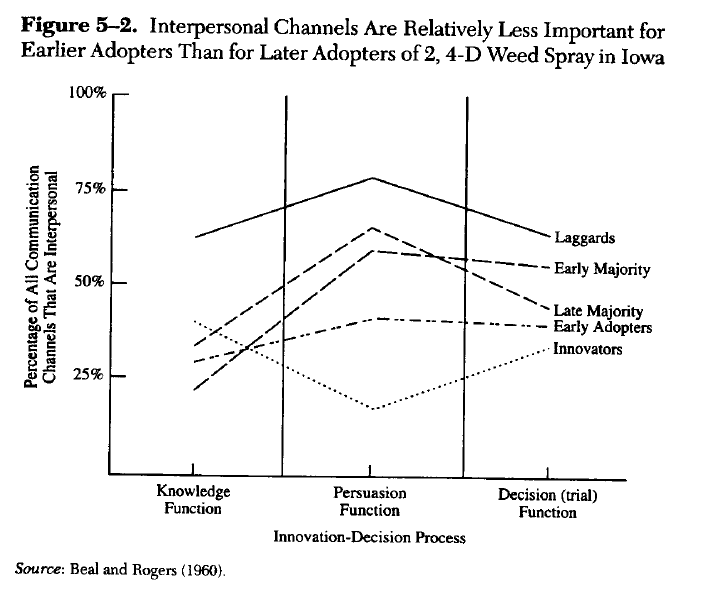
개혁 결정 기간 225후기채택자: 대인채널 중요 (지역적 지식의 확산으로 말미암아 매스미디어의 메시지의 효과보다, 주변인의 입이 더 큰 작용을 한다).

[PNG image (28.61 KB)]
인지와 지식의 비율과 채택률 225
채택자 범주 분류에 따른 개혁 결정 기간의 길이 226
인터넷이 어떻게 개혁 결정 과정을 변화시키고 있는가 227
요약 228
2.6. 06 개혁의 특성과 채택률 ¶
백인 미국사회의 흑인 음악: 랩 232
채택률 233
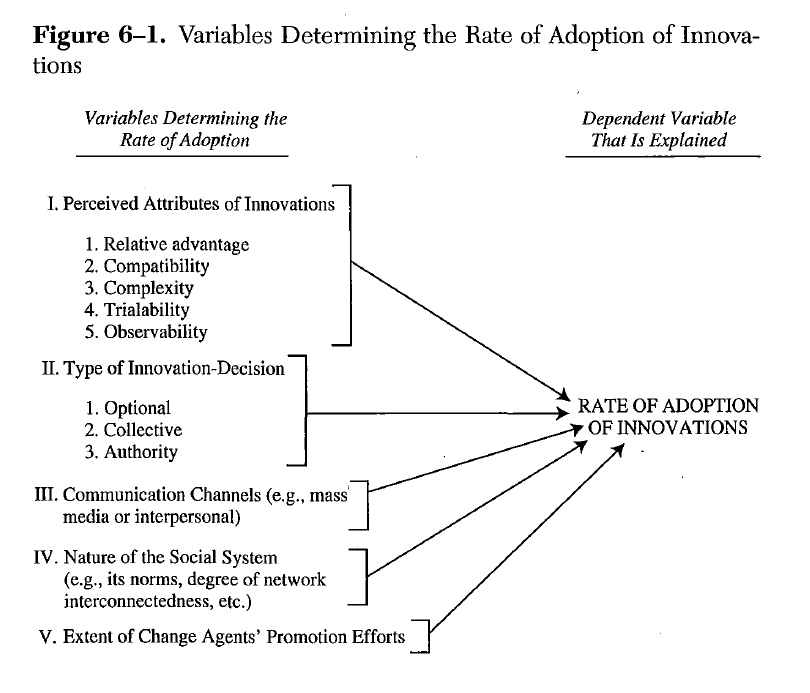
개혁 특성에 관한 연구 235
개혁 특성의 측정 236
채택 단위로서의 조직 238
사후추정 대 예측 239
실패한 농업 개혁 240

개혁의 채택속도를 결정하는 요소들 [PNG image (34.92 KB)]
개혁 특성의 측정 236
채택 단위로서의 조직 238
사후추정 대 예측 239
실패한 농업 개혁 240
상대적 이점 242
경제적 요인과 채택률 242
개혁의 사회적 지위와 관련된 측면 243
과도 채택 245
상대적 이점과 채택률 246
예방 개혁 247
인센티브의 효과 250
위로부터 요구되는 채택 253
경제적 요인과 채택률 242
개혁의 사회적 지위와 관련된 측면 243
과도 채택 245
상대적 이점과 채택률 246
예방 개혁 247
인센티브의 효과 250
위로부터 요구되는 채택 253
적합성 254
가치와 신념과의 적합성 255
이전에 도입된 아이디어와의 적합성 258
개혁대상자의 요구와의 적합성 261
백만 가구의 지붕 위에 설치된 광발전 기구 262
말하지 않는 며느리 262
적합성과 채택률 264
기술 클러스터 264
개혁에 이름달기 266
개혁 포지셔닝 267
수용가능성 연구 269
전통적 지식 체계 270
가치와 신념과의 적합성 255
이전에 도입된 아이디어와의 적합성 258
개혁대상자의 요구와의 적합성 261
백만 가구의 지붕 위에 설치된 광발전 기구 262
말하지 않는 며느리 262
적합성과 채택률 264
기술 클러스터 264
개혁에 이름달기 266
개혁 포지셔닝 267
수용가능성 연구 269
전통적 지식 체계 270
복잡성 274
시험가능성 275
관찰가능성 275
휴대전화와 라이프스타일 혁명 276
요약 281
시험가능성 275
관찰가능성 275
휴대전화와 라이프스타일 혁명 276
요약 281
2.7. 07 개혁성과 채택자 범주 ¶
안데스 콜롬비아 마을의 농업 개혁의 확산 285
개혁성에 기초한 채택자 범주 분류 288
채택의 S형 곡선과 정규분포 288
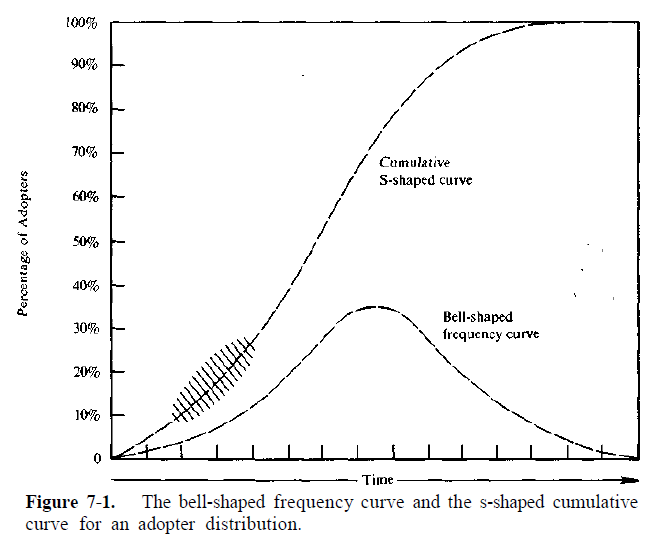
채택의 S형 곡선과 정규분포 288

Adoptors Distribution [PNG image (19.38 KB)]
조직의 개혁성 측정하기 292
누가 채택하는가? 294
누가 채택하는가? 294
채택자 범주화 296
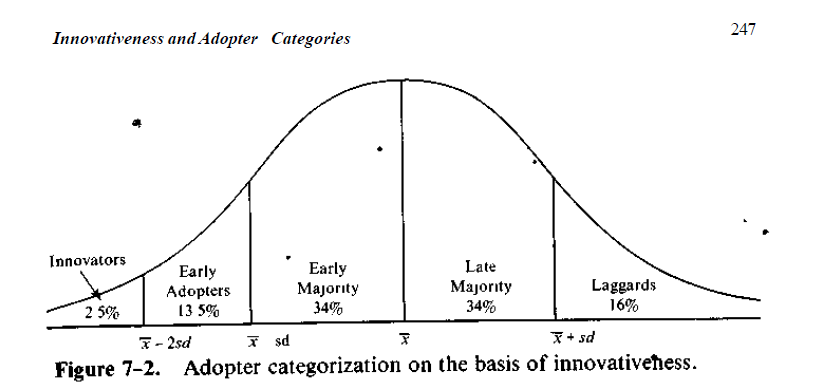
![[http]](/imgs/http.png) Diffusion of VCR
Diffusion of VCR

[PNG image (34.96 KB)]
- Innovators
- Early Adoptor
- Early Majority
- Late Majority
- Laggards
![[http]](/imgs/http.png) Diffusion of VCR
Diffusion of VCR이념형으로 본 채택자 범주 299
모험심이 강한 개혁자 300
존경받는 조기 채택자 300
신중한 조기 대다수 301
회의적인 후기 대다수 302
전통적인 비개혁자 302
개혁에 ‘아니오’라고 말하는 사람들: 구 암만파 신도집단 303
모험심이 강한 개혁자 300
존경받는 조기 채택자 300
신중한 조기 대다수 301
회의적인 후기 대다수 302
전통적인 비개혁자 302
개혁에 ‘아니오’라고 말하는 사람들: 구 암만파 신도집단 303
채택자 범주의 특성 305
사회경제적 특성 306
개성 변인 307
커뮤니케이션 행위 309
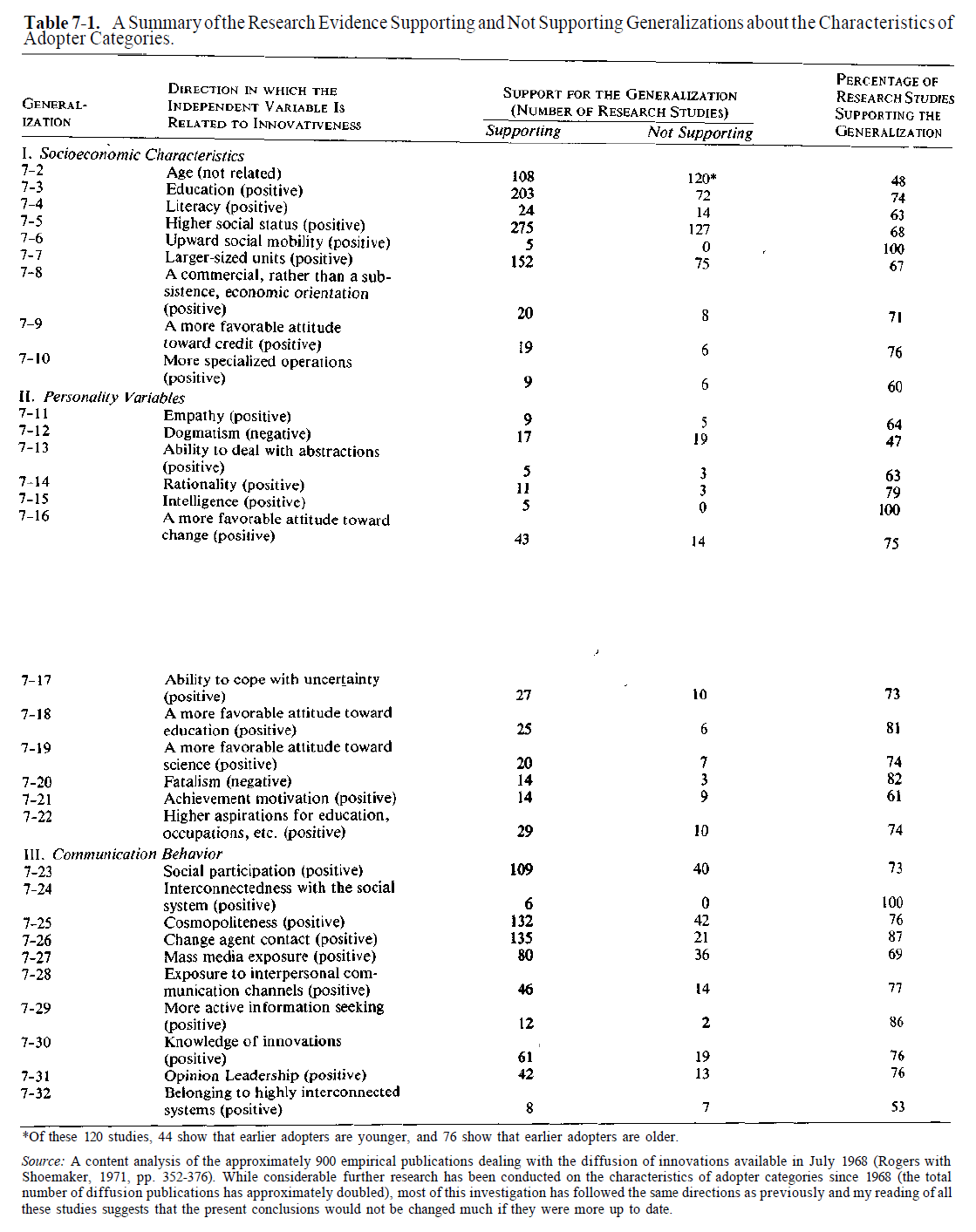
수용자 세분화와 채택자 범주 311
홍콩에서의 휴대전화 비개혁자 313
개혁성-필요 패러독스와 최소 저항의 전략 314
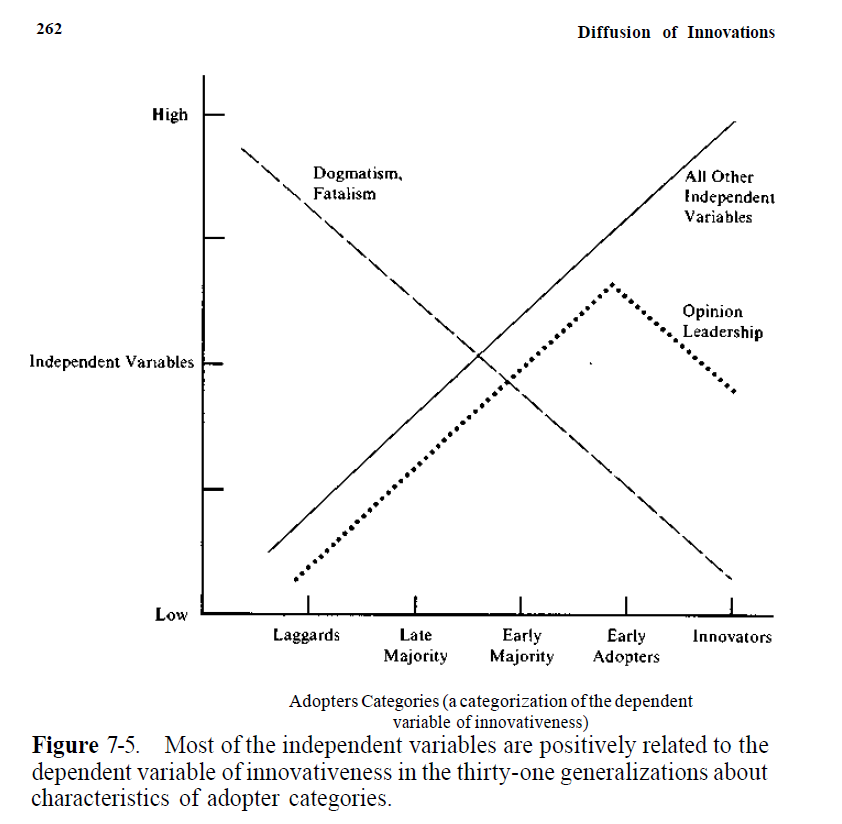
네트워크의 개혁성에 미치는 영향 316
요약 317
사회경제적 특성 306
개성 변인 307
커뮤니케이션 행위 309

A Summary of the Research Evidence Supporting and Not Supporting Generalizations about the Characteristics of Adopter Categories. [PNG image (94.42 KB)]
수용자 세분화와 채택자 범주 311
홍콩에서의 휴대전화 비개혁자 313
개혁성-필요 패러독스와 최소 저항의 전략 314

[PNG image (56.78 KB)]
네트워크의 개혁성에 미치는 영향 316
요약 317
- Generalization 7-1: Adopter distributions follow a bellshaped curve over time and approach normality.
- Generalization 7-2: Earlier adopters are not different from later adopters in age. There is inconsistent evidence about the relationship of age and innovativeness; about half of the 228 studies on this subject show no relationship, 19 percent show that earlier adopters are younger, and 33 percent indicate they are older.
- Generalization 7-3: Earlier adopters have more years of education than later adopters have.
- Generalization 7-4: Earlier adopters are more likely to be literate than are later adopters.
- Generalization 7-5: Earlier adopters have higher social status than later adopters.
- Generalization 7-6: Earlier adopters have a greater degree of upward social mobility than later adopters.
- Generalization 7-7: Earlier adopters have larger-sized units (farms, companies, and so on) than later adopters (Figure 7-3).
- Generalization 7-8: Earlier adopters are more likely to have a commercial (rather than a subsistence) economic orientation than are later adopters. A subsistence orientation is typified by a village farmer who produces only for his own consumption and not for sale Innovativeness is higher with the advent of a commercial orientation in which farm products are raised for market.
- Generalization 7-9: Earlier adopters have a more favorable attitude toward credit (borrowing money) than later adopters.
- Generalization 7-10: Earlier adopters have more specialized operations than later adopters.
- Generalization 7-11: Earlier adopters have greater empathy than later adopters.
- Generalization 7-12: Earlier adopters may be less dogmatic than later adopters.
- Generalization 7-13: Earlier adopters have a greater ability to deal with abstractions than later adopters.
- Generalization 7-14: Earlier adopters have greater rationality than later adopters.
- Generalization 7-15: Earlier adopters have greater intelligence than later adopters.
- Generalization 7-16: Earlier adopters have a more favorable attitude toward change than later adopters.
- Generalization 7-17: Earlier adopters are more able to cope with uncertainty and risk than later adopters.
- Generalization 7-18: Earlier adopters have a more favorable attitude toward education than later adopters.
- Generalization 7-19: Earlier adopters have a more favorable attitude toward science than later adopters. Because most innovations are the products of scientific research, it is logical that innovators should be more favorably inclined toward science.
- Generalization 7-20: Earlier adopters are less fatalistic than later adopters. Fatalism is the degree to which an individual perceives a lack of ability to control his or her future. An individual is more likely to adopt an innovation if he or she believes that he or she is in control, rather than thinking that the future is determined by fate.
- Generalization 7-21: Earlier adopters have higher levels of achievement motivation than later adopters. Achievement motivation is a social value that emphasizes a desire for excellence in order for an individual to attain a sense of personal accomplishment.
- Generalization 7-22: Earlier adopters have higher aspirations (for education, occupations, and so on) than later adopters.
- Generalization 7-23: Earlier adopters have more social participation than later adopters.
- Generalization 7-24: Earlier adopters are more highly interconnected in the social system than later adopters.
- Generalization 7-25: Earlier adopters are more cosmopolite than later adopters.
- Generalization 7-26: Earlier adopters have more change agent contact than later adopters (Figure 7-3).
- Generalization 7-27: Earlier adopters have greater exposure to mass media communication channels than later adopters.
- Generalization 7-28: Earlier adopters have greater exposure to interpersonal communication channels than later adopters.
- Generalization 7-29: Earlier adopters seek information about innovations more actively than later adopters.
- Generalization 7-30: Earlier adopters have greater knowledge of innovations than later adopters.
- Generalization 7-31: Earlier adopters have a higher degree of opinion leadership than later adopters.
- Generalization 7-32: Earlier adopters are more likely to belong to highly interconnected systems than are later adopters.
2.8. 08 확산 네트워크 ¶
근대 수학의 확산에 있어서 의견지도력 320
커뮤니케이션 흐름에 대한 모델들 322
피하주사 모델 322
동질성과 이질성 325
확산의 걸림돌로서의 동질성 326
피하주사 모델 322
- Bullet theory | Hyper-needle Model (of Communication)
- Two step flow
- weakness of mass communication
- finding of opinion leader
- the importance of interpersonal communication
- weakness of mass communication
동질성과 이질성 325
확산의 걸림돌로서의 동질성 326
의견지도력과 네트워크 연결의 측정 329
신형 전자게임기를 위한 바이러스 마케팅에서의 “알파 강아지”들의 역할 334
신형 전자게임기를 위한 바이러스 마케팅에서의 “알파 강아지”들의 역할 334
단일형 의견지도력과 복합형 의견지도력 335
폴 리비어의 한밤 중 활약 335
폴 리비어의 한밤 중 활약 335
의견지도자들의 특성 337
외부 커뮤니케이션 338
접근성 338
사회경제적 지위 339
개혁성 339
개혁성, 의견지도력 그리고 체계 규범 340
의견지도 조직 341
의견지도자는 중요한가? 343
의약품 확산에 있어서의 네트워크 348
외부 커뮤니케이션 338
접근성 338
사회경제적 지위 339
개혁성 339
개혁성, 의견지도력 그리고 체계 규범 340
의견지도 조직 341
의견지도자는 중요한가? 343
의약품 확산에 있어서의 네트워크 348
확산 네트워크 352
도미니카공화국에서 방전변환공학의 확산을 위한 네트워크 형성 352
군집 연구 354
존 스노우 박사와 런던에서의 콜레라 확산 357
커뮤니케이션 네트워크 분석 359
‘약한 연대의 강력함’ 이론 361
네트워크에서 누가 누구와 연결되어 있는가? 363
사회학습이론 364
도미니카공화국에서 방전변환공학의 확산을 위한 네트워크 형성 352
군집 연구 354
존 스노우 박사와 런던에서의 콜레라 확산 357
커뮤니케이션 네트워크 분석 359
‘약한 연대의 강력함’ 이론 361
네트워크에서 누가 누구와 연결되어 있는가? 363
사회학습이론 364
상호작용적 개혁의 확산에서의 결정적 다수 365
팩스의 확산과 결정적 다수 367
인터넷의 확산 368
결정적 다수의 개념 371
관찰당하는 동안 관찰하기 375
잠자는 책 377
채택을 위한 개인적 분계점 379
왜 사람들은 결정적 다수가 형성되기 전에 채택하는가? 380
네트워크가 지니는 높은 설명력 384
결정적 다수에 이르기 위한 전략 384
요약 386
팩스의 확산과 결정적 다수 367
인터넷의 확산 368
결정적 다수의 개념 371
관찰당하는 동안 관찰하기 375
잠자는 책 377
채택을 위한 개인적 분계점 379
왜 사람들은 결정적 다수가 형성되기 전에 채택하는가? 380
네트워크가 지니는 높은 설명력 384
결정적 다수에 이르기 위한 전략 384
요약 386
2.8.1. 일반화 ¶
- Generalization 8-1: Interpersonal diffusion networks are mostly homophilous.
- Generalization 8-2: When interpersonal diffusion networks are heterophilous, followers seek opinion leaders of higher socioeconomic status.
- Generalization 8-3: When interpersonal diffusion networks are heterophilous, followers seek opinion leaders with more education.
- Generalization 8-4: When interpersonal diffusion networks are heterophilous, followers seek opinion leaders with greater mass media exposure.
- Generalization 8-5: When interpersonal diffusion networks are heterophilous, followers seek opinion leaders who are more cosmopolite.
- Generalization 8-6: When interpersonal diffusion networks are heterophilous, followers seek opinion leaders with greater change agent contact.
- Generalization 8-7: When interpersonal diffusion networks are heterophilous, followers seek opinion leaders who are more innovative.
- Generalization 8-8: Opinion leaders have greater exposure to mass media than their followers.
- Generalization 8-9: Opinion leaders are more cosmopolite than their followers.
- Generalization 8-10: Opinion leaders have greater change agent contact than their followers (Figure 8-2).
- Generalization 8-11: Opinion leaders have greater social participation than their followers.
- Generalization 8-12: Opinion leaders have higher socioeconomic status than their followers.
- Generalization 8-13: Opinion leaders are more innovative than their followers (Figure 8-2).
- Generalization 8-14: When a social system's norms favor change, opinion leaders are more innovative, but when the norms do not favor change, opinion leaders are not especially innovative.
- Generalization 8-15 states that: The interconnectedness of an individual in a social system is positively related to the individual's innovativeness.
- Generalization 8-16: The information-exchange potential of communication network links is negatively related to their degree of(1) communication proximity and (2) homophily. *
- Generalization 8-17 states: Individuals tend to be linked to others who are close to them in physical distance and who are relatively homophilous in social characteristics. *
2.9. 09 개혁주도자 ¶
표적화 390
연결자로서의 개혁주도자 392
개혁주도자 역할의 연속성 393
강압적인 확산: 인도네시아의 노르플란트 확산 사파리 396
개혁주도자 역할의 연속성 393
강압적인 확산: 인도네시아의 노르플란트 확산 사파리 396
개혁주도자 성공의 요인 397
개혁주도자의 노력 398
개혁대상자 정향 399
개혁대상자 필요와의 적합성 400
지속성: 나이지리아의 “치킨” 데이비스 401
개혁주도자의 공감 402
개혁주도자의 노력 398
개혁대상자 정향 399
개혁대상자 필요와의 적합성 400
지속성: 나이지리아의 “치킨” 데이비스 401
개혁주도자의 공감 402
커뮤니케이션 캠페인 403
이집트에서의 ORT 캠페인 406
이집트에서의 ORT 캠페인 406
동질성과 개혁주도자의 접촉 407
개혁주도자의 지위가 낮은 개혁대상자와의 접촉 409
준 전문적인 보조원 410
개혁주도자의 공신력 411
보조원의 불확실한 전문성 413
볼티모어에서의 주사바늘 교환 프로젝트 413
개혁주도자의 지위가 낮은 개혁대상자와의 접촉 409
준 전문적인 보조원 410
개혁주도자의 공신력 411
보조원의 불확실한 전문성 413
볼티모어에서의 주사바늘 교환 프로젝트 413
의견지도자 이용 414
실연의 역할 415
실연의 역할 415
개혁대상자의 평가 능력 417
농업 협력 연구소 418
농업 협력 연구소 418
중앙집중적 확산체계와 탈중심적 확산체계 421
탈중심적 확산의 장단점 424
요약 426
탈중심적 확산의 장단점 424
요약 426
2.10. 10 조직에서의 개혁 ¶
개혁 결정의 유형 430
조직 431
가상 조직들 433
가상 조직들 433
조직의 개혁성 435
규모와 조직의 개혁성 437
구조적 특성과 조직의 개혁성 439
개혁후원자의 역할 442
규모와 조직의 개혁성 437
구조적 특성과 조직의 개혁성 439
개혁후원자의 역할 442
조직에서의 개혁 과정 445
새로운 커뮤니케이션 테크놀로지의 채택 447
새로운 커뮤니케이션 테크놀로지의 채택 447
개혁 과정의 단계 448
1. 의제 설정 449
2. 일치화 451
3. 재정의/재구조화 451
4. 명료화 455
5. 일상화 457
산타모니카 고속도로의 다이아몬드 차선 실험: 개혁 이행의 실패 459
1. 의제 설정 449
2. 일치화 451
3. 재정의/재구조화 451
4. 명료화 455
5. 일상화 457
산타모니카 고속도로의 다이아몬드 차선 실험: 개혁 이행의 실패 459
조직의 새로운 커뮤니케이션 기술 461
요약 461
요약 461
2.11. 11 개혁의 결과 ¶
북극구(atctic)의 설상차 혁명 465
개혁 결과에 관한 연구 467
개혁의 결과 분류 470
바람직한 결과 대 바람직하지 못한 결과 470
직접적인 결과 대 간접적인 결과 474
ORT: 결과들의 결과 475
예측된 결과 대 예측되지 않은 결과 477
석기시대에 사는 오스트레일리아 원주민을 위한 쇠도끼 478
바람직한 결과 대 바람직하지 못한 결과 470
직접적인 결과 대 간접적인 결과 474
ORT: 결과들의 결과 475
예측된 결과 대 예측되지 않은 결과 477
석기시대에 사는 오스트레일리아 원주민을 위한 쇠도끼 478
개혁의 형태, 기능, 그리고 의미 480
아일랜드의 감자 기근 481
아일랜드의 감자 기근 481
역동성 균형의 달성 482
모기 살충제 483
모기 살충제 483
개혁 결과에서의 평등 485
커뮤니케이션 효과의 격차 489
개혁 확산의 결과에 따른 격차 확대 490
사회 구조와 결과의 평등성 492
격차를 좁히기 위한 전략 494
격차의 확대가 필연적인 것은 아니다 498
디지털 격차 499
요약 500
커뮤니케이션 효과의 격차 489
개혁 확산의 결과에 따른 격차 확대 490
사회 구조와 결과의 평등성 492
격차를 좁히기 위한 전략 494
격차의 확대가 필연적인 것은 아니다 498
디지털 격차 499
요약 500












